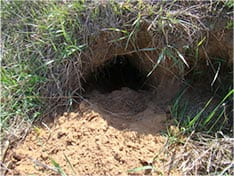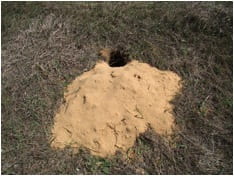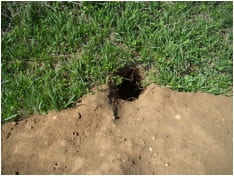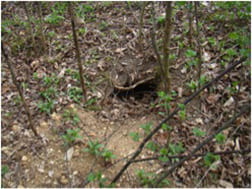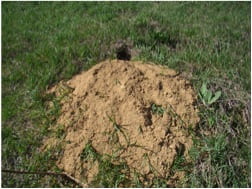For hair collection to be successful, we have to locate fresh burrows. Fresh burrows are usually still in use by the resident badger, and therefore are the best chance of obtaining hair. In some cases, the occupant may be currently in the burrow, so when approaching a burrow, use caution as badgers may defend their burrows if they feel threatened. Badgers often dig several burrows in a night, so their home range can contain many diggings.
This page includes specific details on:
- Examples of variation in badger burrow features (see the Badger ID section for more general descriptions).
- How to judge if the particular burrow is fresh.
All photos on this page were taken in Wisconsin by Elizabeth Kierepka unless noted.
Variation in Badger Burrows
Entrance Shape
Badger burrows are typically egg-shaped, but a large amounts of variation exists. Generally, the entrance is wider than it is tall due to the breast-stroke digging style of badgers.
Burrow shape can vary from the typical egg shape (left; Marquette County) to almost a perfect circle (middle and right; Jefferson County).
Dirt Plume Size
Dirt plume size can also vary between burrows. Some burrows have plumes that measure more than ten feet long. Larger plumes tend to be in sandy or loamy hillsides such as along roads or along agricultural field edges. In forested habitats, dirt plumes can be harder to find as leaves can obscure the area.
Excavated dirt from burrows can be difficult to see in some cases (left; Washington County), but the majority of burrows have a distinctive pile of dirt behind them. Badgers will dig in multiple soil types, but appear to prefer sandier soils (middle; Marquette County). Burrows can also be found near riverine areas (right; Marquette County).
Fresh Burrows
Identifying Fresh Burrows
Fresh burrows are the most difficult evidence of badger activity to locate. Reports of these burrows are essential, so below are examples of fresh burrows and features that will help in aging a potential burrow. If you encounter a fresh burrow, contact us immediately, these are usually the only types of burrows that we can obtain viable DNA samples.
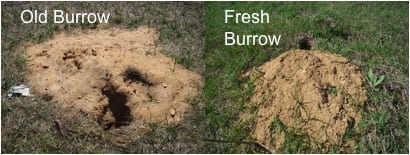
Grasses grow in dirt plumes of old burrows (left; Jefferson County), but fresh burrow dirt plumes often cover plants (right; Marquette County)
1.) Loose soil in the plume, especially toward the entrance of the burrow.
Loose dirt indicates that the badger dug out the burrow recently, and may be still in the burrow. Badgers often return and use old burrows, but there will be fresh dirt from “maintenance digging”.
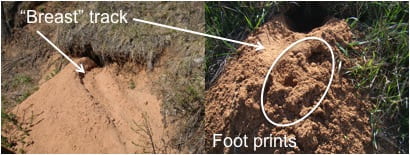
Breast tracks are commonly found on burrows (left; Bayfield County). Foot prints often are on the side of a breast track (right; Marquette County).
2.) Tracks in the dirt plume and inside the burrow.
Tracks include foot prints and “breast tracks” which often look like a waterslide coming out of the burrow. Breast tracks result from a badger’s stomach being dragged as the animal enters or leaves.
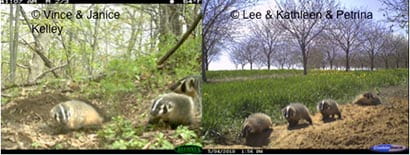
Mother badgers with their kits are among the many different activities that can be captured with a trail camera. Photos like these (left; Juneau County, right; Door County) are the best confirmation that a burrow is active.
3.) Trail cameras are one of the best ways to verify if a burrow is being used.
If you have found a burrow on your property, setting up a trail camera is a great way to see without disturbing the burrow itself. As a rule, only set up a trail camera on private property.
